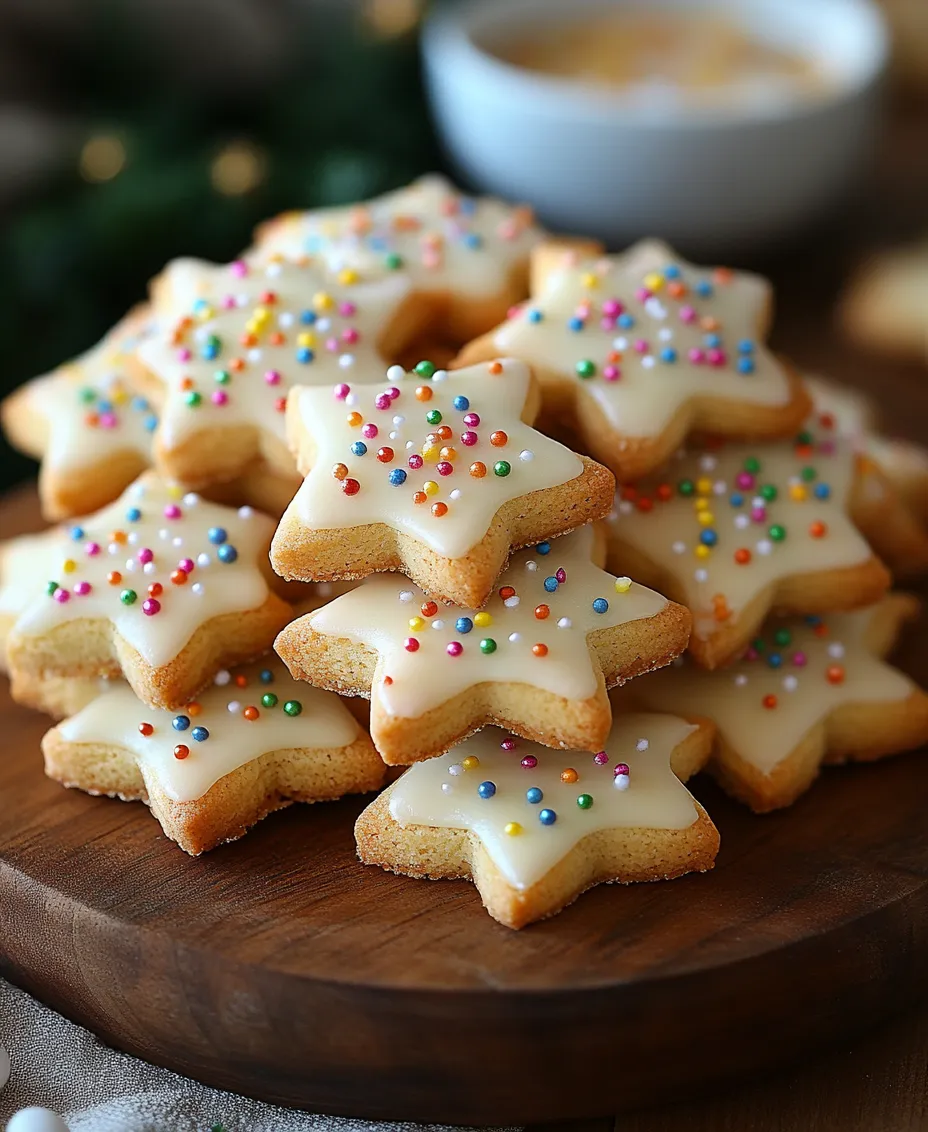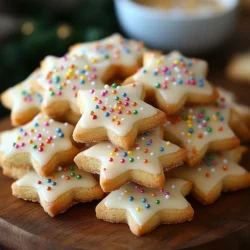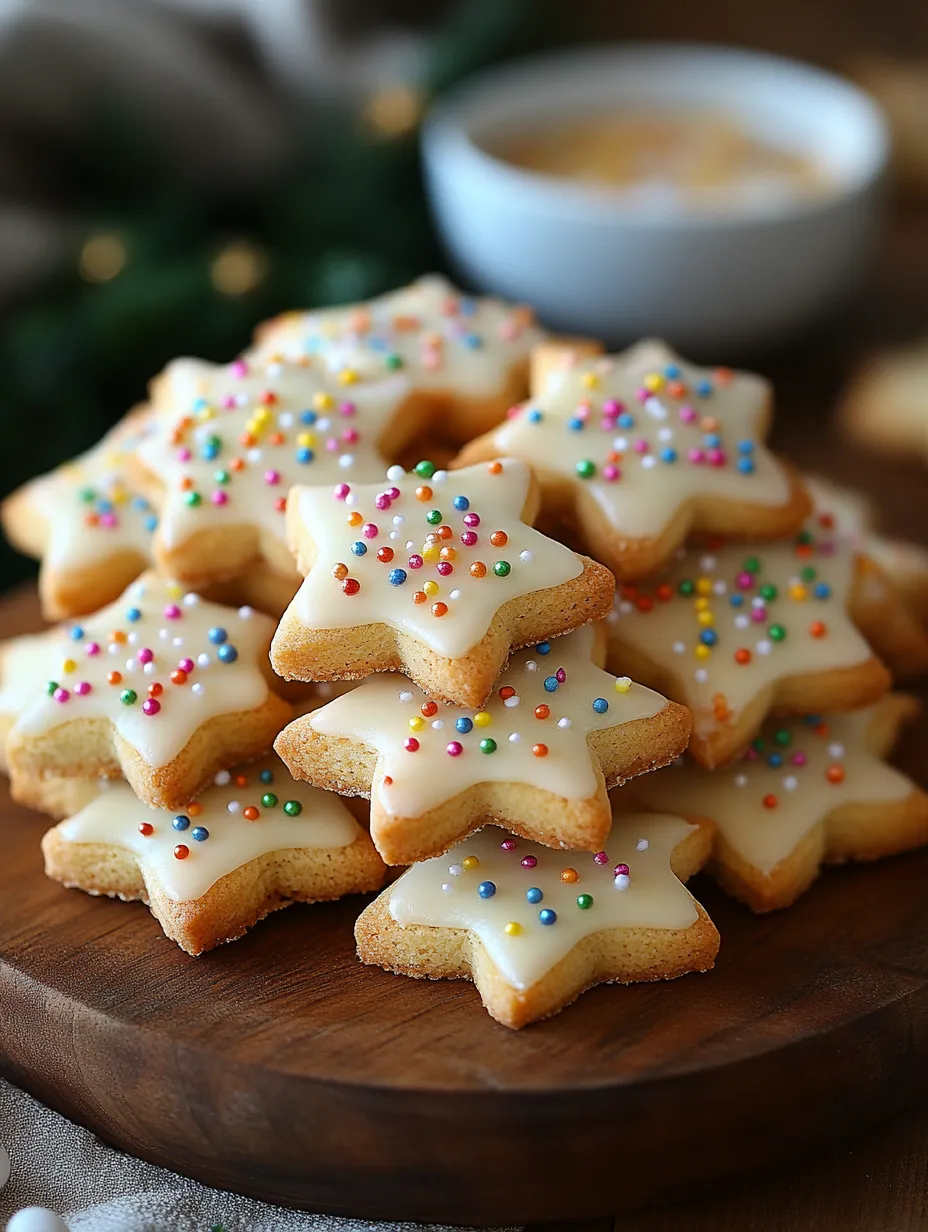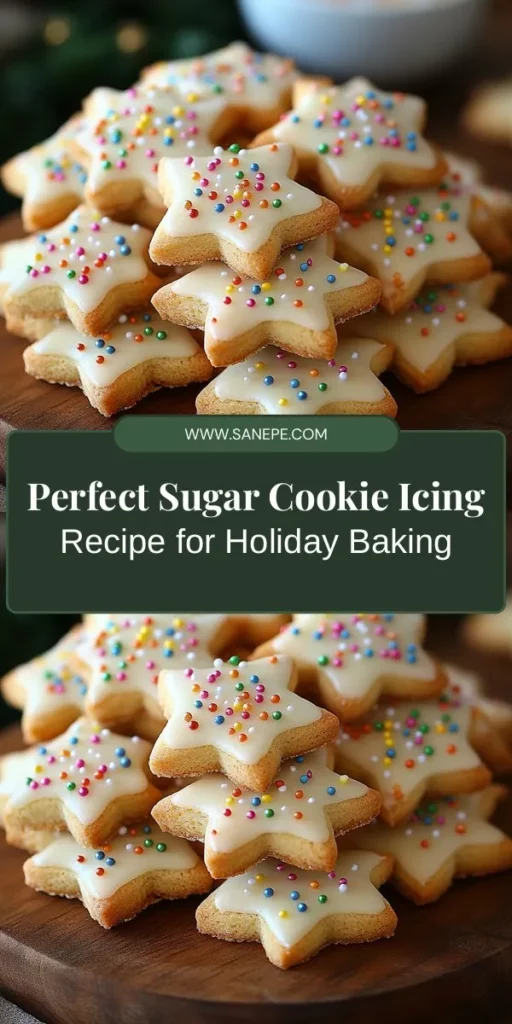Introduction
The holiday season is synonymous with sweet treats, and among the most cherished delights are sugar cookies. Their soft, buttery texture and sweet flavor have made them a timeless favorite at festive gatherings, from family parties to cookie exchanges. What truly elevates these cookies, however, is the icing that adorns them. Beautifully decorated sugar cookies not only bring a festive spirit to any occasion but also make for delightful gifts and table centerpieces.
This article presents a detailed guide on creating sugar cookie icing that hardens perfectly, allowing you to achieve stunning designs that maintain their shape and beauty long after the cookies have cooled. Unlike traditional icing, which can be soft and prone to smudging, this hardening icing recipe transforms your cookie creations into works of art. With a simple list of ingredients and straightforward instructions, this icing recipe will be your go-to for all your holiday baking needs.
Understanding Sugar Cookie Icing
The Role of Icing in Sugar Cookie Decoration
Icing serves a dual purpose when it comes to decorating sugar cookies. First and foremost, it enhances the aesthetic appeal of the cookies, allowing bakers to unleash their creativity and create visually stunning designs. From intricate patterns to simple outlines, icing can transform a plain cookie into a festive masterpiece. Moreover, icing adds an additional layer of sweetness, complementing the rich flavor of the sugar cookie itself.
There are several types of icing used in cookie decoration, including royal icing, glaze icing, and fondant. Each type has its unique properties and applications. For instance, royal icing is made with egg whites or meringue powder, making it ideal for detailed decorations that require hardening. On the other hand, glaze icing offers a shinier finish but may not hold intricate designs as well. Understanding these differences is key to choosing the right icing for your decorative needs.
What Makes This Icing Unique
What sets this sugar cookie icing apart is its hardening properties. Once applied to your cookies, it dries to a smooth, firm finish that not only looks beautiful but also allows for stacking and storing without fear of smudging or losing shape. This characteristic is particularly beneficial for those who want to create elaborate designs or for bakers who wish to package their cookies as gifts.
Additionally, this icing is incredibly versatile, accommodating various decorating techniques. Whether you’re piping delicate details, flooding the cookie surface, or creating a smooth finish, this icing recipe provides the stability you need to execute your vision flawlessly. With this icing in your arsenal, you can confidently tackle any festive baking project.
Ingredients Breakdown
Essential Ingredients for Sugar Cookie Icing
To make sugar cookie icing that hardens perfectly, you will need the following essential ingredients:
1. Powdered Sugar: This is the foundation of your icing. Its fine texture allows for a smooth finish and easy incorporation of other ingredients. When mixed with liquid, powdered sugar dissolves quickly, creating a creamy consistency that is easy to work with.
2. Meringue Powder: Often regarded as the “magic” ingredient in this recipe, meringue powder is what gives the icing its hardening properties. It is made from dried egg whites and stabilizers, creating a solid structure when the icing dries. This is crucial for achieving those clean, crisp lines that are the hallmark of beautifully decorated cookies.
3. Water: Water is added to achieve the perfect consistency for your icing. The right balance of water to powdered sugar and meringue powder will determine how thick or thin your icing is, which affects how it spreads and holds its shape.
4. Optional Flavorings and Colors: To personalize your icing, you can incorporate various flavorings, such as vanilla extract, almond extract, or citrus zest. Additionally, food coloring can be used to create vibrant hues that match your holiday theme or occasion.
Step-by-Step Instructions
Preparation: Setting Up Your Workspace
Before you dive into mixing your ingredients, it’s essential to set up a clean and organized workspace. A clutter-free area will not only help you work efficiently but also keep your ingredients safe from contamination. Gather all the necessary tools and equipment, which typically include:
– Mixing bowls
– Electric mixer or whisk
– Sifter
– Piping bags and tips (if you plan to pipe designs)
– Food coloring and flavorings
– Offset spatula or knife for spreading
Mixing the Ingredients
1. Sifting Powdered Sugar: Start by sifting your powdered sugar into a mixing bowl. This step is crucial as it removes any lumps, ensuring a smooth icing consistency. Sifting also aerates the sugar, which helps achieve a lighter texture.
2. Incorporating Meringue Powder: Next, add the meringue powder to the sifted powdered sugar. The typical ratio is 1 tablespoon of meringue powder for every 4 cups of powdered sugar. This will provide the necessary stability to your icing.
3. Achieving the Right Consistency with Water: Gradually add water to the powdered sugar and meringue mixture, starting with a small amount (about 2 tablespoons). Use an electric mixer or whisk to blend the ingredients. Continue adding water, one tablespoon at a time, until you reach your desired consistency. For outlining cookies, aim for a thicker consistency, while for flooding, a thinner, more pourable texture is ideal.
Flavoring and Coloring Your Icing
1. The Addition of Vanilla Extract: To enhance the flavor of your icing, consider adding a teaspoon of vanilla extract or your preferred flavoring. This will add a delightful taste that complements the sweetness of the sugar cookies.
2. How to Safely Incorporate Food Coloring: If you want to add color to your icing, this is the time to do so. Use gel food coloring for vibrant colors, as it doesn’t alter the consistency of the icing as much as liquid food coloring. Start with a small amount, mixing it in thoroughly, and add more until you reach your desired shade. Remember that colors can deepen as the icing dries, so it’s wise to start lighter than you think.
Achieving the Perfect Texture
Once you have mixed your icing to the desired consistency and flavor, it’s time to test it. To check the texture, dip a spatula into the icing and lift it out. The icing should hold its shape for a few seconds before slowly melting back into the bowl. If it runs off too quickly, you may need to add a bit more powdered sugar to thicken it up. Conversely, if it’s too thick to pipe, add a little more water until it achieves the right balance.
By following these steps, you will have a beautifully crafted icing that hardens perfectly for your sugar cookies. This icing not only enhances the visual appeal of your holiday treats but also makes them a joy to eat. So, as you prepare to spread festive cheer this season, remember that the right icing can make all the difference in your cookie decorating endeavors.

Using a Hand Mixer: The Right Approach
When preparing your sugar cookie icing, using a hand mixer can significantly improve the mixing process, ensuring a smooth and consistent texture. Begin by placing your powdered sugar in a mixing bowl and adding your liquid ingredients (typically water or milk) gradually. Start on a low speed to prevent a cloud of powdered sugar from escaping the bowl. Once the ingredients start to combine, increase the speed to medium until the icing reaches a glossy and thick consistency.
It is essential to mix just until combined—over-mixing can incorporate too much air, leading to a fluffy icing that won’t harden properly. Aim for about 1-2 minutes of mixing time. The final icing should be thick enough to hold its shape when piped but still fluid enough for flooding techniques.
Signs of Over-Mixing and How to Avoid It
While mixing is crucial, paying attention to the signs of over-mixing can prevent a disaster. If you notice the icing becoming too airy or fluffy and losing its sheen, you’ve likely over-mixed it. The key is to watch for a smooth, glossy finish without excessive bubbles. To avoid over-mixing, use the mixer on a lower speed and mix in short bursts, checking the consistency frequently. If your icing becomes too thick, you can always add a few drops of water to adjust.
Preparing for Application
Before applying your icing, it’s essential to prepare adequately to ensure flawless results. One of the most common issues bakers encounter is crusting, which can make it challenging to achieve the desired finish. To prevent this, cover the icing with plastic wrap directly on the surface, ensuring no air pockets remain. This covering will keep the icing moist until you are ready to use it.
Choosing the Right Piping Tools for Decorating
Investing in quality piping tools can elevate your cookie decorating game. A set of piping bags and various tips is essential. For outlining cookies, a small round tip (like a #1 or #2) works best, while a wider tip (like a #3 or #4) is ideal for flooding. Consider using disposable piping bags for easy cleanup, and always have a coupler on hand to switch between tips without wasting icing.
Techniques for Decorating Sugar Cookies
Basic Piping Techniques
Outlining Cookies: Creating a Clean Border
Outlining your cookies is an essential first step in the decorating process. Begin by filling your piping bag with your stiff icing mixture. Start at one edge of the cookie and apply even pressure as you pipe a continuous line around the perimeter. This outline will serve as a barrier for the flooded icing, preventing it from spilling over the edges. Ensure the line is smooth and steady, which will help maintain a polished look.
Flooding Cookies: Filling in with a Smooth Finish
Once your outline is complete, it’s time to flood the cookie. To do this, dilute your icing slightly with water for a smoother consistency. Using the same piping bag but with a larger tip, fill in the area inside your outline with icing. Use a toothpick or a scribe tool to gently spread the icing and eliminate any air bubbles. Aim for a smooth, level surface, and allow the flooded icing to settle.
Advanced Techniques
Creating Designs: Layering Colors and Effects
Once your base layer is set, you can get creative with colors and designs. To layer colors effectively, pipe a second layer of icing after the first has dried slightly (but is not fully set). This technique allows for blending and marbling effects, adding depth to your cookies. Additionally, consider using edible glitter or sprinkles to further enhance your designs.
Using Stencils and Tools for Detailed Work
For intricate designs, stencils can be a game-changer. Lay a stencil over your set icing and gently dust with powdered sugar or cocoa powder to create detailed patterns. Alternatively, use food-safe markers or airbrush kits for a more polished appearance. The key is to practice your technique, as precision will lead to stunning results.
Drying and Setting the Icing
The Importance of Drying Time
Allowing your icing to dry properly is crucial for achieving that hard, glossy finish. Depending on the humidity and temperature of your environment, drying times can vary. Ideally, allow your iced cookies to dry at room temperature for at least 6 hours, or overnight if possible. This will ensure that the icing hardens appropriately and is less likely to smudge when stacked or packaged.
Recommended Drying Conditions for Optimal Results
For optimal drying, place your cookies in a dry area away from direct sunlight and drafts. If you live in a humid climate, consider using a dehumidifier or air conditioning to maintain a stable environment. Avoid covering the cookies while they are drying, as this can trap moisture and prevent proper hardening.
Factors Affecting Drying Time
Several factors can influence the drying time of your icing. Humidity levels, the thickness of your icing, and the size of the cookies all play a role. Thicker layers of icing will take longer to dry, so be mindful of your application techniques. If you are in a rush and need to speed up the drying process, a gentle fan can help circulate air around the cookies without disturbing the icing.
What to Expect as Icing Dries
Changes in Texture and Appearance
As your icing dries, you will notice several changes. Initially shiny, the icing will gradually become matte as moisture evaporates. The texture will also firm up, creating a smooth, hard surface that is ideal for stacking and decorating. If you used multiple layers, observe how they interact as they dry; they may blend together or create interesting textures.
Troubleshooting Common Issues During Drying
Should you encounter issues during the drying process, such as bubbling or cracking, don’t worry. These problems can often be rectified. If you see bubbles forming, gently pop them with a toothpick while the icing is still wet. For cracks, a fine-tipped piping bag with a little extra icing can be used to fill in the gaps once the surface has set.
Storage and Preservation of Icing
How to Store Leftover Icing
If you have leftover icing, storing it properly is essential for maintaining its quality. Place it in an airtight container and cover it with plastic wrap pressed directly against the surface to prevent drying. Icing can be stored in the refrigerator for up to two weeks. When you’re ready to use it again, allow it to come to room temperature and stir well before application.
Reusing Icing: Tips for Storage and Consistency
When reusing stored icing, you may notice it has thickened. To restore its consistency, add small amounts of water, mixing thoroughly until it reaches the desired thickness. Always test the icing on a cookie to ensure it pipes well and maintains the integrity of your designs.
Preserving Decorated Cookies
How to Store Decorated Cookies to Maintain Freshness
Once your cookies are decorated and the icing is set, proper storage is crucial for maintaining both freshness and appearance. Store decorated cookies in a single layer in an airtight container. If stacking is necessary, place parchment paper between layers to prevent the icing from sticking.
Ideal Conditions for Long-Term Storage
For the best results, keep your decorated cookies in a cool, dry place. If you plan to store them for an extended period, consider freezing them. Wrap each cookie individually in plastic wrap and then place them in an airtight freezer bag. Thaw at room temperature before serving for optimal taste and texture.
Conclusion
Creating sugar cookie icing that hardens is an essential skill for any holiday baker. This recipe provides a reliable method for achieving the perfect consistency and durability, ensuring your sugar cookies not only taste delicious but also look stunning. With a little practice and creativity, you can transform ordinary cookies into extraordinary festive treats that will impress family and friends alike. Embrace the joy of baking this holiday season, and let your decorated cookies shine! Whether you’re mastering basic piping techniques or exploring advanced designs, the possibilities are endless. Happy decorating!


